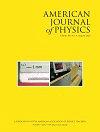弹跳胶囊的动力学:脉冲模型与赫兹模型的对比
IF 0.8
4区 教育学
Q3 EDUCATION, SCIENTIFIC DISCIPLINES
引用次数: 0
摘要
胶囊状物体与球体不同,如果它有初始自旋,就能反弹到比掉落时更高的高度。本文比较了这一现象的两个定量模型:基于冲量的解析模型和基于力的赫兹模型。我们通过实验研究了冲击角速度和接触角对胶囊反弹速度和角速度的影响。实验结果表明,我们的赫兹模型成功地与我们的冲量模型达成了一致。我们将赫兹模型的比较成功归功于其对碰撞过程中摩擦的滑粘行为的复杂处理。本文章由计算机程序翻译,如有差异,请以英文原文为准。
Dynamics of a bouncing capsule: An impulse model vs a Hertzian model
A capsule-shaped object, unlike a sphere, can rebound to a higher height than it is dropped from if it has an initial spin. In this paper, we compare two quantitative models of this phenomenon: an impulse-based analytic model and a force-based Hertzian model. We experimentally studied the effects of impact angular velocity and contact angle on the capsule's rebounding velocity and angular velocity. Our experimental findings showed successful agreement with our Hertzian model but not with our impulse model. We attribute the comparative success of the Hertzian model to its intricate treatment of the slip–stick behavior of friction during the collision.
求助全文
通过发布文献求助,成功后即可免费获取论文全文。
去求助
来源期刊

American Journal of Physics
物理-物理:综合
CiteScore
1.80
自引率
11.10%
发文量
146
审稿时长
3 months
期刊介绍:
The mission of the American Journal of Physics (AJP) is to publish articles on the educational and cultural aspects of physics that are useful, interesting, and accessible to a diverse audience of physics students, educators, and researchers. Our audience generally reads outside their specialties to broaden their understanding of physics and to expand and enhance their pedagogical toolkits at the undergraduate and graduate levels.
 求助内容:
求助内容: 应助结果提醒方式:
应助结果提醒方式:


